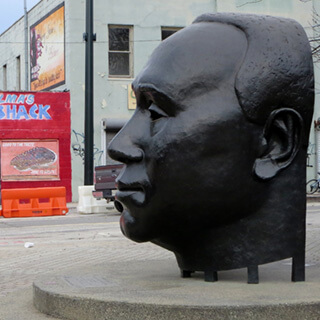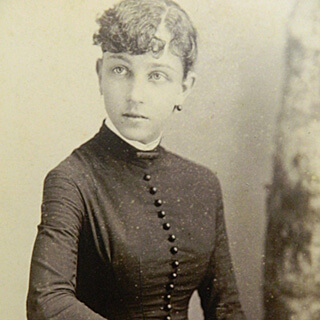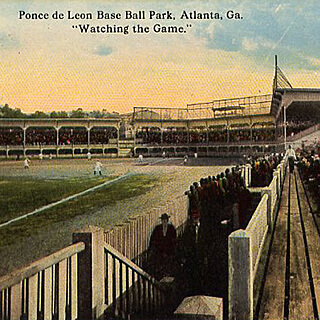Overview
Through the case of Jackson Hill, LeAnn Lands describes the turn toward residential segregation in early twentieth-century Atlanta.
Introduction
In spite of increasing animosity between workers and elites, blacks and whites, through the turn of the century, Atlanta's residential landscape remained curiously heterogeneous in terms of race and class. Blacks and whites, business owners and laborers lived in close proximity in the late 1800s, often on the same block.
If the home-owning whites who occupied the distinguished homes lining Jackson Hill, just east of the Atlanta's downtown, were uncomfortable with the presence of African Americans in the area, it did not surface publicly until 1910. That year, local whites attempted to remove historically black Morris Brown College to another part of the city. When blacks declined to move, whites drew and announced a boundary line to prevent what they called "Negro encroachment" and "invasion." When black families continued renting and purchasing homes within Jackson Hill, whites adopted tactics common throughout the urban South and increasingly utilized in the urban North; in 1913 they proposed a city ordinance outlining racial residential segregation procedures. This early conflict in Jackson Hill, which coincided with an emerging fashion for the development of racially homogeneous park-neighborhoods such as Ansley Park and Druid Hills, marked a turn toward an Atlanta increasingly characterized by residential segregation.
 |
| Library of Congress, Peachtree Street, Atlanta, Georgia, 1907. |
A City Divided
Located just east of Atlanta's central business district in the city's lower Fourth Ward, Jackson Hill housed white New South entrepreneurs and an emerging middle and upper class. Most of the larger homes on Jackson Street, Houston Street, and Boulevard dated to the 1880s, and their building footprints suggest the era's prevalent Queen Anne–style architecture, a style popular among the region's elite. In his memoir, attorney and Georgia assemblyman Walter McElreath recalled the section as distinguished. Not simply the home of the city's emerging elite, Jackson Hill housed an "old guard," a distinction McElreath made clear when he explained that "the homes on Houston and Jackson streets and North Boulevard were occupied by some of the most prominent and well-to-do people of the city"; Peachtree Street, McElreath explained, housed "the nouveau riche and social strugglers." Surrounding the grander homes of Houston, Boulevard, and Jackson, "less prominent people and those of smaller means lived on Johnson Avenue, Randolph Street, Highland Avenue . . . East Avenue, Rice Street, Angier Avenue, Morgan Street, and Pine Street, which at that time were very respectable streets."1Walter McElreath, Walter McElreath: An Autobiography (Macon, Georgia: Mercer University Press, 1984). To McElreath, Jackson Hill was well-off—and white.
African American resident Millie Jordan remembered an area that elite whites tried to ignore. Jordan recalled Houston Street, which intersected with Jackson, as "one of the very finest black residential streets in what was once called the Old Fourth Ward." She pointed to the many prominent families who once lived on Houston, including Walter White, the executive secretary of the NAACP. Real-estate agent Antoine Graves and builder Alexander Hamilton lived around the corner on Howell. To Jordan, "This ward was the elite section of its day."2Quoted in Michael L. Porter, "Black Atlanta: An Interdisciplinary Study of Blacks on the East Side of Atlanta, 1890–1930," PhD Dissertation, Emory University, 1974.
 |
| George F. Cram, Layout of Atlanta's Ward System (Fourth Ward in blue), 1874. |
Discomfited by an influx of rental housing and change in the neighborhood after 1900, white elites attempted to control black population growth in the lower Fourth Ward by diverting potential new residents to the west side of the city. Specifically, when a fire damaged historically black Morris Brown College in January 1910, whites sought the opportunity to purchase the property for the "greater white development" of the lower Fourth Ward and offered the college acreage to rebuild in a new location on the west side of town, assuming that the institution would attract the growing black population away from Jackson Hill.3Atlanta Constitution, March 4, 1910. White home-owning residents of the Fourth Ward went to considerable lengths to push through the relocation of Morris Brown, a major African American institution in the hopes that the black populace would follow. They organized meetings between white political leadership and school and African Methodist Episcopal Church officials. They offered cash. They offered land. And black Fourth Warders declined each.
Faced with effective black resistance, Jackson Hill's white home-owning residents met in October 1910 to delineate a fourteen block area in the neighborhood with a racial boundary line and, as the Atlanta Constitution reported, "put the public and all real estate developers on notice that the sale or renting of property within the white territory [specified] would be considered a reprehensible and unfriendly act."4Atlanta Constitution, October 10, 1910.
As the Constitution also noted, it was the "prominent citizens" of the Jackson Hill area who met in Grace Methodist Church to introduce the boundary proposal, and the list of attendees was remarkably similar to the committee named to study the Morris Brown move. B. Lee Smith, an advertising solicitor for the Georgian, led the meeting. Attorney Walter McElreath, attorney Eugene Mitchell, and real-estate dealer J. C. Baldwin all spoke in support of the proposed boundary line.5Atlanta Constitution, October 12, 1910.
 |
| Library of Congress, Morris Brown, Stone Hall (now Fountain Hall), date unknown. |
Attendees debated the causes and potential "remedies" to black movement within the neighborhood. McElreath and Mitchell complained that streetcar access brought African Americans into the area, and they proposed rerouting the car lines. Others blamed Bishop C. S. Smith of Morris Brown College, who they claimed was encouraging blacks to settle in the area "and mix with whites." Lee Smith identified real-estate agents as the culprits for purported racial change. Curiously, no one commented on Atlanta's burgeoning population growth, black and white, though the real-estate agents were acutely aware of the tight housing market. The meeting attendees concluded that, "for the best interests of both the white people and colored people," whites and black housing should be segregated, though they did not state why it was in blacks and whites' "best interest."6Atlanta Constitution, October 10, 1910; Atlanta Independent, October 15, 1910; Atlanta Georgian, October 12, 1910. If Mitchell and McElreath were correct, streetcar development helped the black middle class as well as the white middle class to access new housing. Scholars have cited tight housing markets as well as economic status change as reasons blacks moved into formerly white-occupied housing. See Don L. Klima, "Breaking Out: Streetcars and Suburban Development, 1872–1900," Atlanta Historical Society Journal, no. 26 (1982): 67–82.
It is unclear if Jackson Hill's white residents truly expected realtors and landlords to turn black-occupied units over to whites after the 1910 boundary line declaration. Atlanta Independent editor Benjamin Davis scoffed at the prospect and queried,
The Independent would like to know how the race haters . . . are going to dispossess the Negroes of all the homes they own north of Irwin street. . . . Now, Negroes own the property on both sides of Irwin street, east of the Boulevard, and up both sides of Howell street to Houston, down both sides of Houston to the Boulevard, down both sides of Houston street from Hilliard street to Courtland street, on both sides of Cain street, from Fort street to Jackson, and a majority of the property on both sides of Hilliard street, from Houston to Highland.7Atlanta Independent, October 15, 1910. Despite Davis's choice of words, blacks did not own much of that property, but they rented it. Manuscript Census, City of Atlanta, Fulton County, Georgia, US Census of Population, Microfilm, T-624, 1910.
Indeed, a turnover of black-occupied housing to white occupants would have violated racial norms. While white-occupied homes in Atlanta occasionally passed to blacks, black-occupied housing rarely passed to whites. The question was and is moot, however; black families remained in Jackson Hill, and duplex and single-family homes ranging from about four hundred to one thousand square feet continued to be built, rented, or sold to African Americans in the "whites only" area. Johnson Avenue, for example, between Boulevard and Randolph, turned from 100 percent white to 54 percent black from 1911 to 1912.8Atlanta City Directory, 1911, 1912.
If elite whites were concerned about growing black population, it is curious why they waited until 1910 to publicly demand the expulsion of African Americans from what they considered to be a white neighborhood. After all, racial tensions had exploded only four years earlier in a race riot, and residential proximity could have been understood by whites as increasing the likelihood of interactions between black males and white females—a relationship that whites feared. That said, it may not have occurred to whites to demand black residential segregation; after all, social codes and local and state ordinances controlled much of the interaction between whites and blacks already (though obviously these codes could and were violated).9On racial social codes, see Leon Litwack, Trouble in Mind: Black Southerners in the Age of Jim Crow (New York: Knopf, 1998). Perhaps the mixed-race, mixed built environment that existed until about 1900 had been acceptable to elite whites when Jackson Hill and the lower Fourth Ward were less dense. When land use grew more intense and black occupancy increased, elite whites became distressed about more African American homes, which they equated with urban disorder. From 1899 to 1910, the number of households within the declared whites-only area increased by 50 percent. Or whites may have found the changing status of blacks disorienting. No longer were African American families settling for rows of shanties and back-alley tenements. Rather, they seized housing appropriate to their economic status—on the street fronts and occasionally side by side with whites.10This change was calculated using the 1899 and 1910 Atlanta City Directory.
| |
White elites may also have become more acutely aware of land use and urban environments as new models of suburban living filled in the city's perimeter. The neat lawns, well-kept homes, and tranquil scenes identified with the city's park-neighborhoods enticed many former in-town property owners, even if Atlanta's core city did not house the noxious industries that pushed city dwellers to the suburbs of places like Cleveland and Chicago. The Atlanta Constitution regularly updated readers on the progress of park-neighborhood buying and building. In one of his regular columns on "Atlanta Dirt," real-estate investor and agent George Adair described his drive through Ansley Park, noting its "beautifully shaded avenues, all well paved" and "artistic" design.11Atlanta Constitution, September 16, 1906. For those who remained in town, weekend tours to the new park-neighborhoods reminded well-heeled Atlantans of the freshest ideas in architecture, landscape, and living. One 1910 Atlanta Journal article explained that the trolley-car route to Druid Hills was "one of the most attractive trolley rides in the entire system" and would "very likely prove one of the most popular for pleasure rides, as it afford[ed] an opportunity to see the beautiful homes on Peachtree and Ponce de Leon Avenue, as well as the handsome new homes now in Druid Hills."12Atlanta Journal, April 2, 1910 Thus, Jackson Hill's home-owning whites experienced change in their neighborhood's built environment and land use at the same time that new landscape aesthetic trends aroused homeowners' senses. But in Jackson Hill in the early twentieth century, white homeowners did not flee the urban core as density increased (at least initially) but demanded a complete alteration of the existing landscape. 
About the Author
LeeAnn Lands recieved her PhD from the Georgia Institute of Technology's School of History, Technology, and Society in 2001. She is the author of several papers and book chapters that investigate 20th century US urban history, urban geography, housing segregation, and housing landscapes in the US South. LeeAnn Lands resides in Atlanta, Georgia and is an Associate Professor of History and American Studies at Kennesaw State University. The excerpt "A City Divided" comes from LeeAnn Lands' The Culture of Property: Race, Class, and Housing Landscapes in Atlanta, 1880–1950 (Athens: University of Georgia Press, 2009).
Recommended Resources
Lands, LeeAnn. The Culture of Property: Race, Class, and Housing Landscapes in Atlanta, 1880–1950. Athens: University of Georgia Press, 2009.
———. "Be a Patriot, Buy a Home: Re-imagining Home Owners and Home Ownership in Early 20th Century Atlanta." Journal of Social History 41 (2008): 943–965.
———. "A City too Busy to Reflect? Public History, Controversy, and Civic Engagement." In Writing America: Classroom Literacy and Public Engagement, edited by Sarah Robbins and Mimi Dyer. New York: Columbia University/Teachers College Press, 2004, 50–63.
———. "A Reprehensible and Unfriendly Act: Homeowners, Renters, and the Bid for Residential Segregation in Atlanta, 1900-1917." Journal of Planning History 3 (2004): 83–115.
———. "'Speculators Attention!': Workers and Rental Housing Development in Atlanta, 1880–1910." Journal of Urban History 28 (2002): 546–572.
Links
Atlanta History Center
http://www.atlantahistorycenter.com/
LeeAnn Lands
http://www.lalands.com/
Midtown Local Historic District
http://midtownatlanta.org/info/59332?listid=33864
Similar Publications
| 1. | Walter McElreath, Walter McElreath: An Autobiography (Macon, Georgia: Mercer University Press, 1984). |
|---|---|
| 2. | Quoted in Michael L. Porter, "Black Atlanta: An Interdisciplinary Study of Blacks on the East Side of Atlanta, 1890–1930," PhD Dissertation, Emory University, 1974. |
| 3. | Atlanta Constitution, March 4, 1910. |
| 4. | Atlanta Constitution, October 10, 1910. |
| 5. | Atlanta Constitution, October 12, 1910. |
| 6. | Atlanta Constitution, October 10, 1910; Atlanta Independent, October 15, 1910; Atlanta Georgian, October 12, 1910. If Mitchell and McElreath were correct, streetcar development helped the black middle class as well as the white middle class to access new housing. Scholars have cited tight housing markets as well as economic status change as reasons blacks moved into formerly white-occupied housing. See Don L. Klima, "Breaking Out: Streetcars and Suburban Development, 1872–1900," Atlanta Historical Society Journal, no. 26 (1982): 67–82. |
| 7. | Atlanta Independent, October 15, 1910. Despite Davis's choice of words, blacks did not own much of that property, but they rented it. Manuscript Census, City of Atlanta, Fulton County, Georgia, US Census of Population, Microfilm, T-624, 1910. |
| 8. | Atlanta City Directory, 1911, 1912. |
| 9. | On racial social codes, see Leon Litwack, Trouble in Mind: Black Southerners in the Age of Jim Crow (New York: Knopf, 1998). |
| 10. | This change was calculated using the 1899 and 1910 Atlanta City Directory. |
| 11. | Atlanta Constitution, September 16, 1906. |
| 12. | Atlanta Journal, April 2, 1910 |




